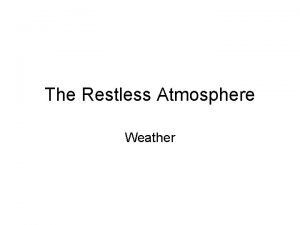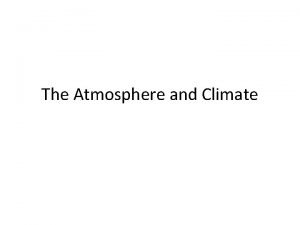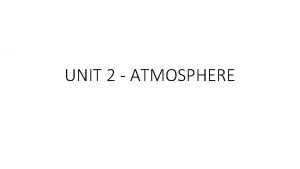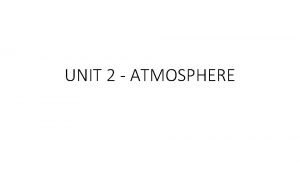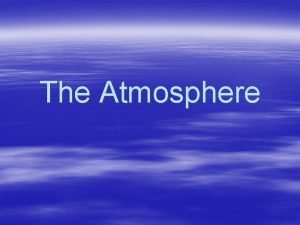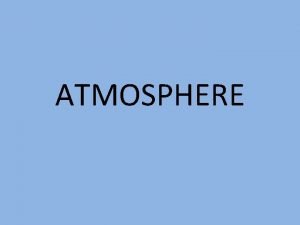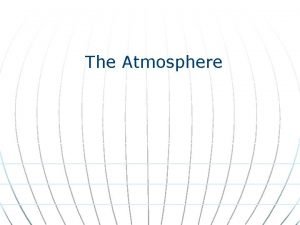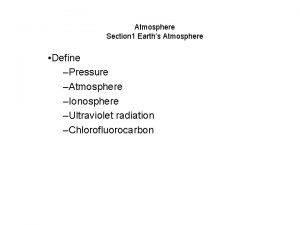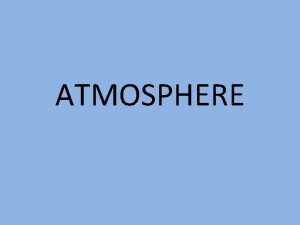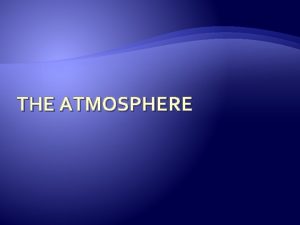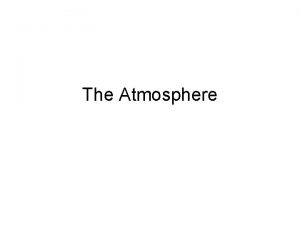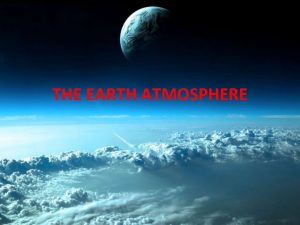TITLE INTRODUCTION TO THE ATMOSPHERE EQ How are






























- Slides: 30

TITLE: INTRODUCTION TO THE ATMOSPHERE EQ: How are the layers of the atmosphere different?

Everyday is a holiday! National Cake day!

A. Weather is a System Definition- the state of Earth’s atmosphere at a particular time and place. Includes: 1. a. types of clouds b. precipitation (rain, snow, sleet) c. storms, even dust storms d. moisture in air e. air pressure f. wind direction

The study of weather and the atmosphere is what branch of Earth Science? Meteorology

Give your best definition of WEATHER! “the state of Earth’s atmosphere at a particular time and place. ”

“Red sky at night, sailors delight Red sky in the morning, sailors warning”

Self Weathercasters Humidity- amount of moisture in the air 1. Increased humidity makes hair wavy & curly 2. Skin feels moist Air Pressure- weight of air 1. Changes in air pressure causes ears to pop 2. Old people say their bones ache.

B. Weather Scales 1. Wind chill Scale= actual temp. vs temp. with wind a. ) shows frostbite potential b. ) frost bite- “frozen body tissue”


There are four degrees of frostbite. This is and example of fourth degree frost bite where only amputation of the affected area will save the patient.

C. Composition of the Atmosphere Nitrogen- most abundant gas= it’s stable 2. Oxygen- 2 nd most abundant 3. Carbon Dioxide- used by plants 4. Water vapor- produces clouds & rain 1. Draw in Notes!

D. Structure of the Atmosphere 1. Different layers are defined by their temperatures.

a. Troposphere- “changing” 1. Temperature cools as elevation increases. 2. Earth’s clouds and weather occur. 3. High amount of density = high air pressure & air mass

What is the main difference that defines the layers of the Atmosphere? *different temperatures!

Why is the air pressure the HIGHEST in the troposphere? Higher air density (more air molecules for gravity to act on).

Why isn’t there more Carbon Dioxide in the air? *Being used by plants & stored in water systems/animals

b. Stratosphere- “layers” 1. contains ozone layer (absorbs energy), causes temp. to increase with altitude

c. Mesosphere: ‘meso’- middle a. Temperature cools as elevation increases. b. Friction of gases protects Earth from meteoroids

d. Thermosphere- “heat” a. absorbs a high amount of solar radiation = Temp. increases with altitude b. Northern lights (Auroras) c. Ionosphere- UV light from the sun causes gas molecules to become electrically charged particles (Ions)…. . Provides radio communication!

Northern Lights- Aurora Borealis

Layers of the Atmosphere http: //www. youtube. com/watch? v=3 Cer. Jb. Z-dm 0

Layers of the Atmosphere Mural Materials: Red text Ruler Colored pencils Mural & Graph Packet

2. ) Exosphere- “outer” portion, extends toward space.

E. Importance of the Atmosphere Stable environment 2. Protection- sun & meteoroids 3. Warmth- water can exist as a liquid 1.

Greenhouse Gases: water vapor, CO 2, methane

Beaufort scale self-cast Assignment Purpose : Learn to use a Meteorological scale to help forecast the weather. Obtain the Beaufort scale handout. 2. Complete the scale drawings and descriptions. Make sure that all sketches are colored with detail. 1. Use pg. 478 in the black text as a resource.

# 3 Unit 2 Essential Vocabulary Troposphere Stratosphere Mesosphere Thermosphere Ionosphere Meteorology Greenhouse effect Greenhouse gases Temperature inversion dew Weather Climate Ozone Insolation Wind chill Humidity Dew point Fog Cloud frost

B. Weather Scales & Models 1. Beaufort Scalerelates wind speed to the effects of land sea.

Quiz 3 Template Know gasses that make up atmosphere. 2. What layer contains the ozone? 3. What layer does weather occur in? 4. What is the BASIS for the division of atmosphere layers? 5. What layer do you live in? 6. What layer is responsible for the break up of meteors? 7. Order the layer from lowest to highest. (place a arrow by each layer to represent whether temp. increases or decreases. ) 8. Know the three greenhouse gases. & how the greenhouse effect works 1.

“The Atmosphere” Video Questions What does the atmosphere block? 2. Describe Bill’s “atmosphere cylinder” experiment, & what were his findings? 3. How do pilot’s determine their current altitude? 4. Describe the difference of air pressure between Death valley & on top of a mountain. Why the difference? 5. Why do your ear’s pop in a plane? 6. Order the five layers of the atmosphere from highest to lowest. 7. Why is it warmer in low cities than in the high mountains? 8. How are Earth’s atmosphere and a greenhouse similar? 9. Bill must run around the track _______ times to simulate the height of the troposphere. 10. Name three topics of the atmosphere that were described in the “weather rap. ” 1.
 Antigentest åre
Antigentest åre Prefatory elements in proposal exclude
Prefatory elements in proposal exclude Title title
Title title Hát kết hợp bộ gõ cơ thể
Hát kết hợp bộ gõ cơ thể Bổ thể
Bổ thể Tỉ lệ cơ thể trẻ em
Tỉ lệ cơ thể trẻ em Voi kéo gỗ như thế nào
Voi kéo gỗ như thế nào Chụp tư thế worms-breton
Chụp tư thế worms-breton Bài hát chúa yêu trần thế alleluia
Bài hát chúa yêu trần thế alleluia Các môn thể thao bắt đầu bằng tiếng đua
Các môn thể thao bắt đầu bằng tiếng đua Thế nào là hệ số cao nhất
Thế nào là hệ số cao nhất Các châu lục và đại dương trên thế giới
Các châu lục và đại dương trên thế giới Công thức tính thế năng
Công thức tính thế năng Trời xanh đây là của chúng ta thể thơ
Trời xanh đây là của chúng ta thể thơ Cách giải mật thư tọa độ
Cách giải mật thư tọa độ 101012 bằng
101012 bằng Phản ứng thế ankan
Phản ứng thế ankan Các châu lục và đại dương trên thế giới
Các châu lục và đại dương trên thế giới Thơ thất ngôn tứ tuyệt đường luật
Thơ thất ngôn tứ tuyệt đường luật Quá trình desamine hóa có thể tạo ra
Quá trình desamine hóa có thể tạo ra Một số thể thơ truyền thống
Một số thể thơ truyền thống Cái miệng bé xinh thế chỉ nói điều hay thôi
Cái miệng bé xinh thế chỉ nói điều hay thôi Vẽ hình chiếu vuông góc của vật thể sau
Vẽ hình chiếu vuông góc của vật thể sau Biện pháp chống mỏi cơ
Biện pháp chống mỏi cơ đặc điểm cơ thể của người tối cổ
đặc điểm cơ thể của người tối cổ Giọng cùng tên là
Giọng cùng tên là Vẽ hình chiếu đứng bằng cạnh của vật thể
Vẽ hình chiếu đứng bằng cạnh của vật thể Phối cảnh
Phối cảnh Thẻ vin
Thẻ vin đại từ thay thế
đại từ thay thế






































